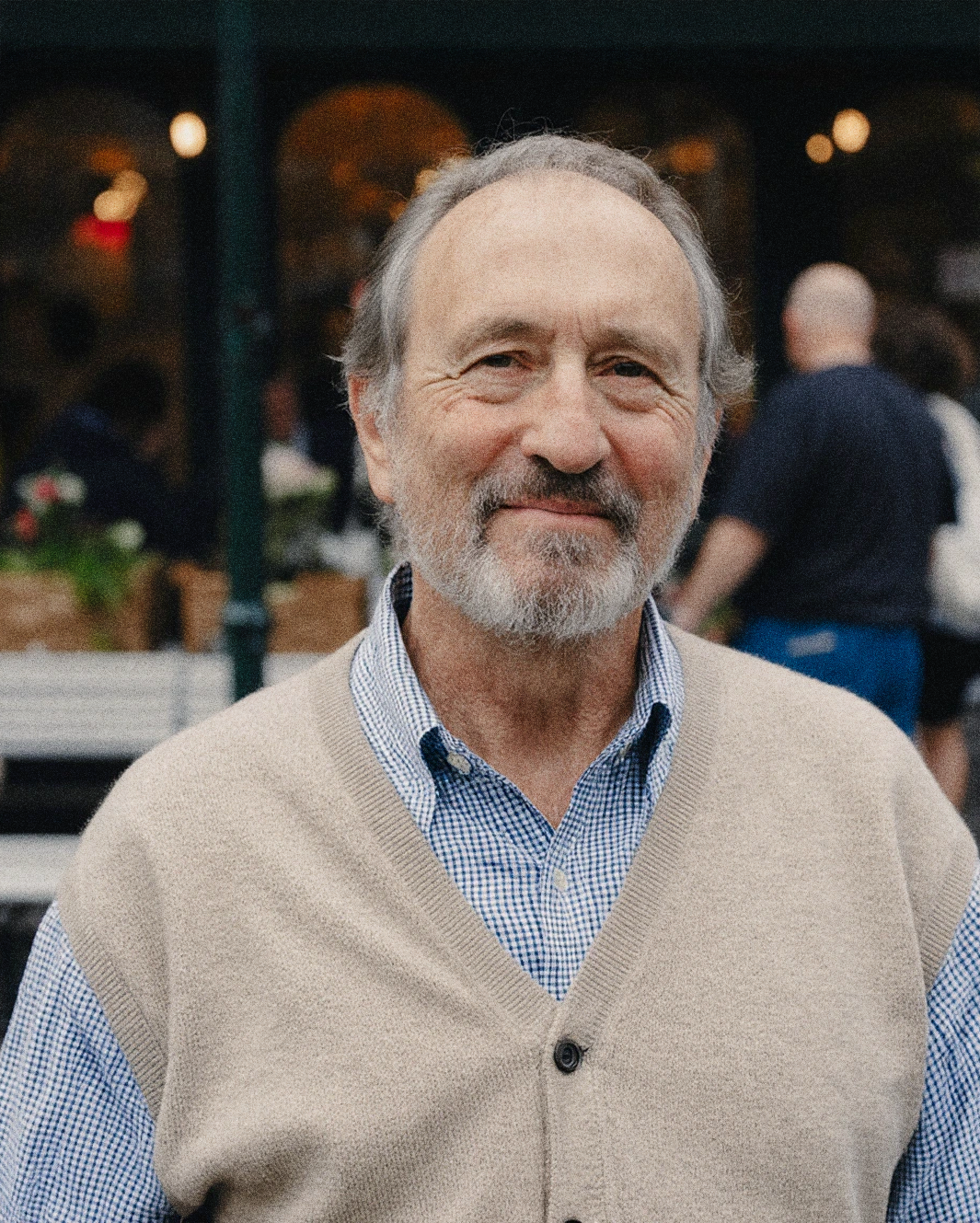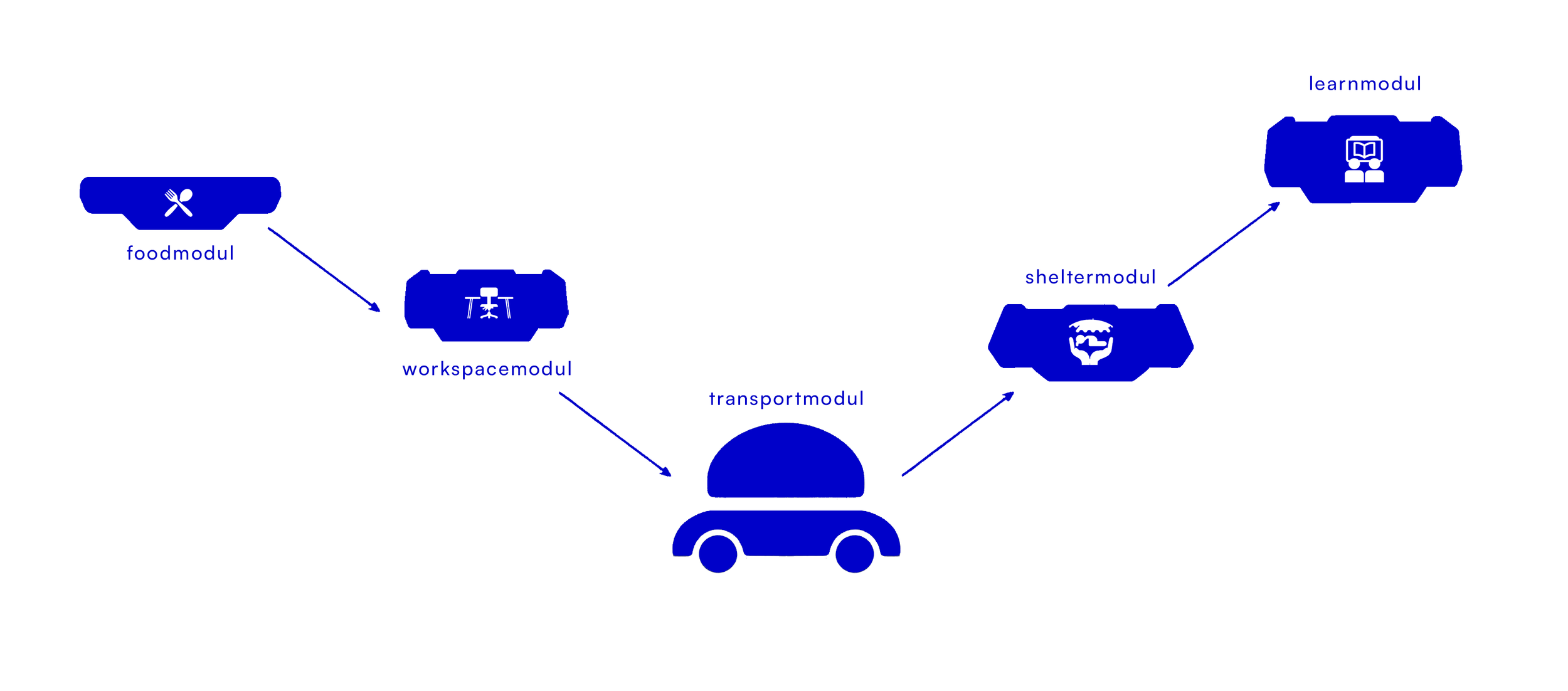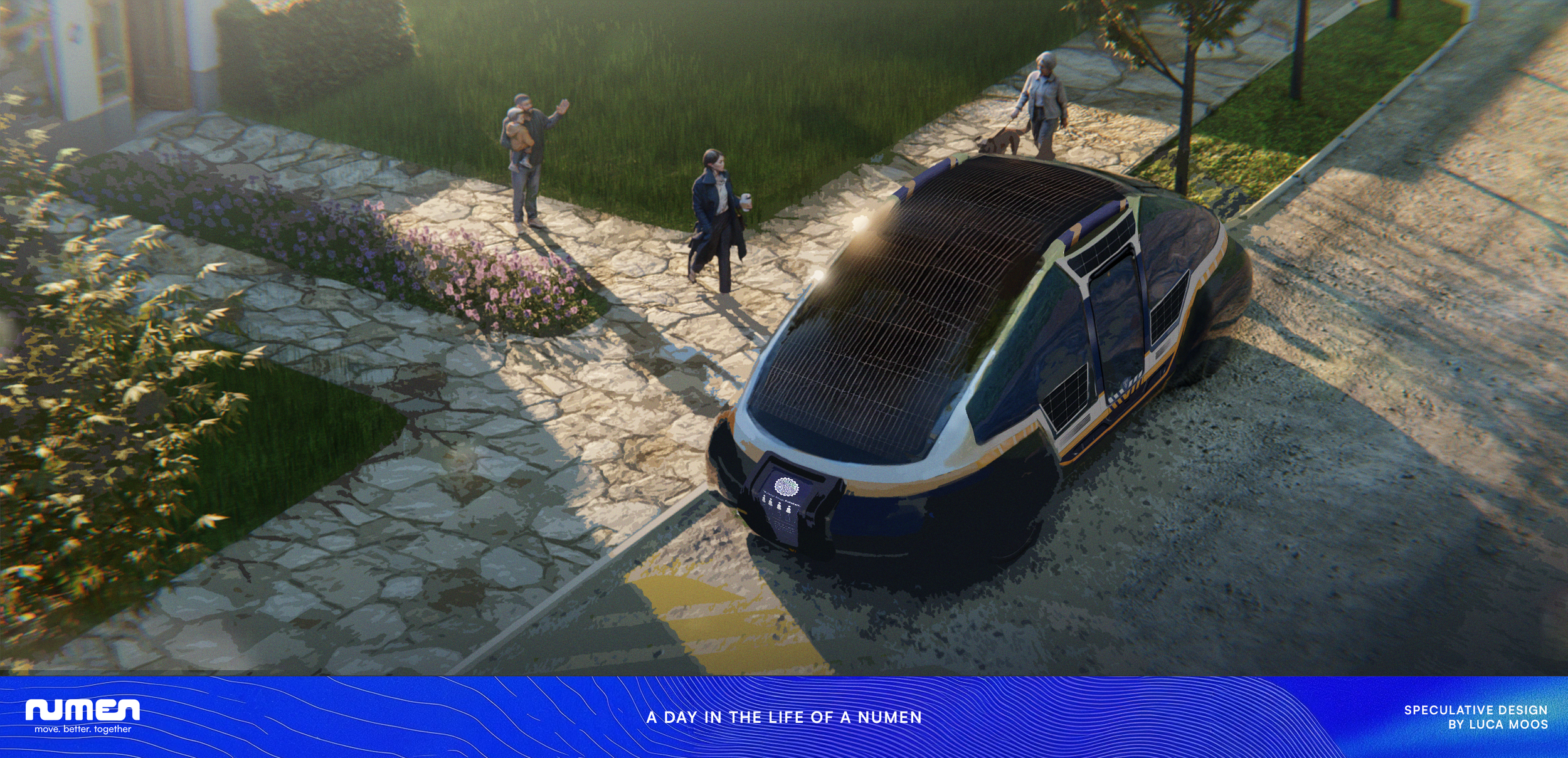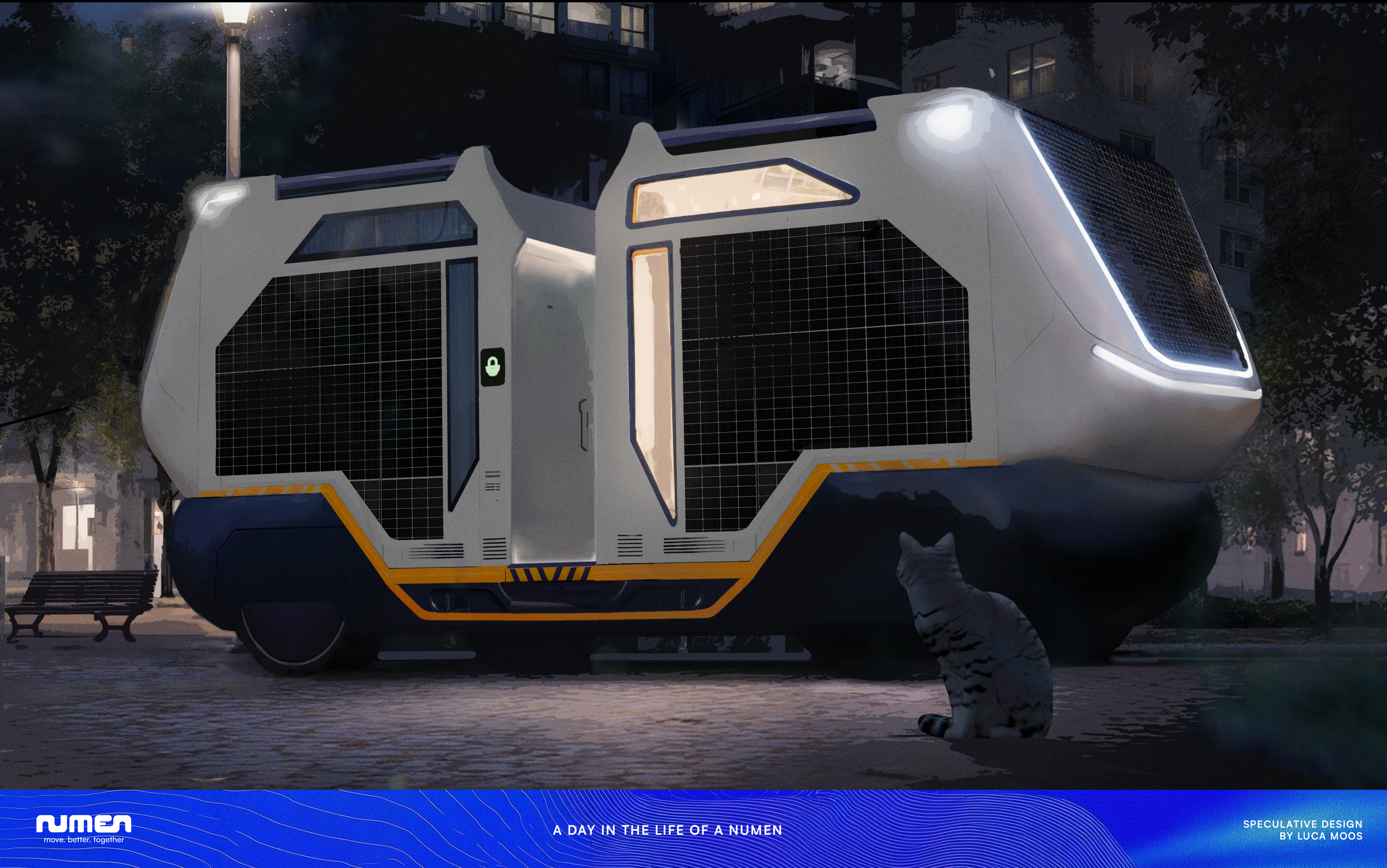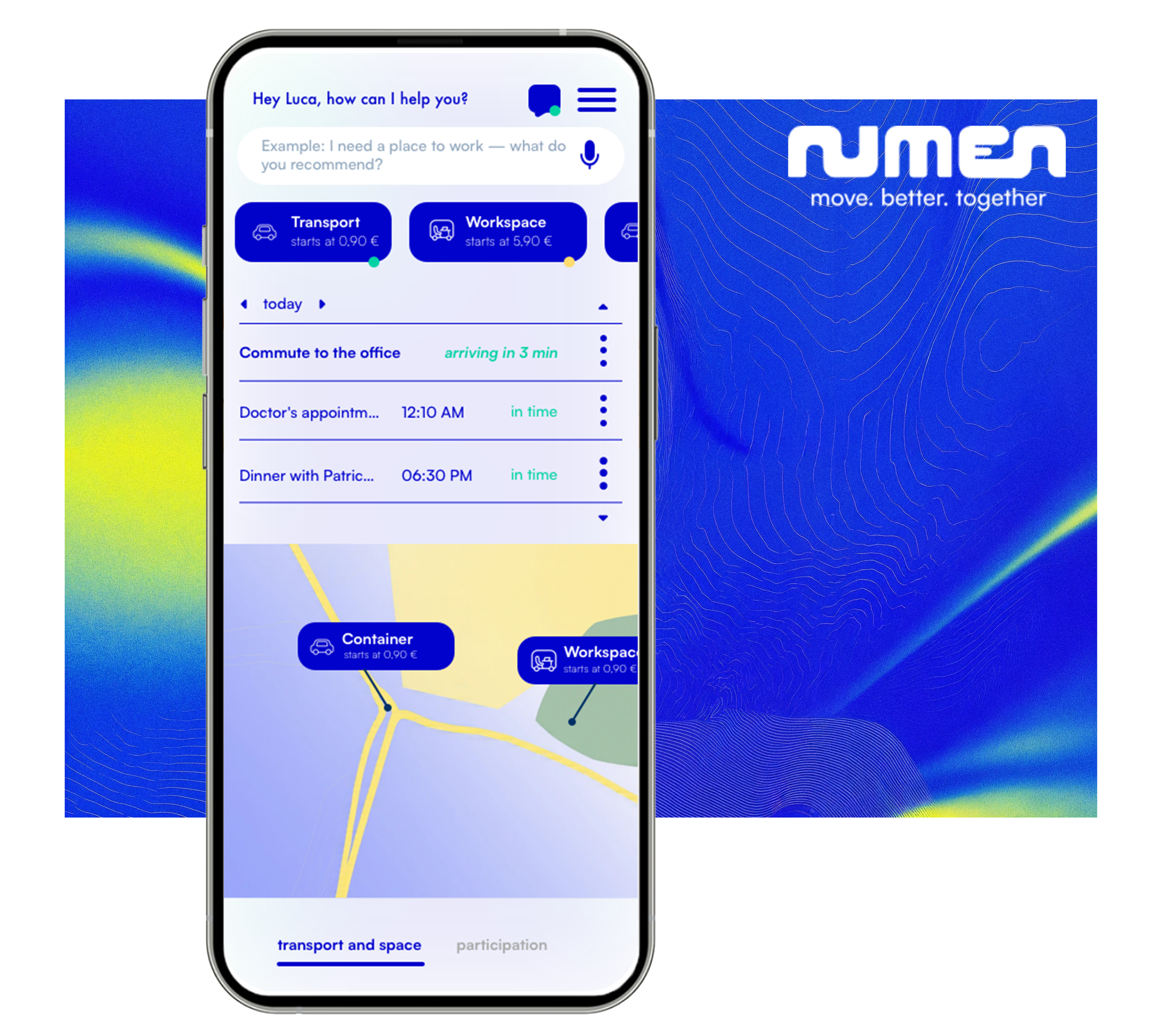STRATEGIC CONCEPT FOR A NEW MOBILITY & URBAN SPACE
At numen, I’m shaping a mobility system that redefines public space — modular, autonomous, and radically fair. I translate a complex vision of community-driven, sustainable transport into a concept that feels human, transparent, and alive.
„Cities have the capability of providing something for everybody, only because, and only when, they are created by everybody.“
Jane Jacobs
numen in a nutshell — a future glimpse
No time to read the full project? No worries. Right here you’ll find a short podcast, generated by me. It sums up the key ideas and lets you just play it and let it sink in while scrolling.
👉 Play & let it sink in.
01 - 02 THE PROBLEM – URBAN MOBILITY AT A DEAD END
The Designchallenge: “How might we design an urban mobility system that reduces inequality, minimizes environmental impact, and transforms mobility into a shared public space?”
Today, over 50% of urban public space in many cities is dedicated to motorized traffic — and private cars, which remain unused 95% of the time, are the single largest occupier of that space. This static, ownership-based mobility model consumes vast amounts of energy, materials, and land, while providing minimal active utility for the majority of citizens.
Globally, urban transport accounts for ~23% of energy-related CO₂ emissions, with private vehicles contributing the dominant share. Even extensive public transport systems often operate on fixed, inflexible schedules and routes, leading to inefficiencies such as underutilization during off-peak hours and overcrowding during rush hour.
Beyond environmental cost, the spatial and social impact is profound: in dense city centers, up to 30% of land value is locked into car parking alone. This reduces space for housing, culture, commerce, and ecological restoration, while reinforcing patterns of exclusion — access to mobility remains tied to personal wealth and vehicle ownership.
Without systemic change, cities risk continuing a cycle of wasted capacity, spatial inequality, and rising emissions, undermining both climate goals and quality of urban life.
03 Research – Understanding Urban Mobility
To ground the vision in real needs, I conducted exploratory research combining desk research and interviews. While shadowing in real traffic situations would have added further depth, it was not feasible within the scope of this project. Instead, I carried out a series of semi-structured interviews with peers and friends living in urban contexts, who shared their daily mobility routines, frustrations, and aspirations.
This process revealed not only the environmental impact of current mobility systems, but also the lived experiences of citizens who struggle with inefficiency, exclusion, and a lack of alternatives beyond private car ownership. By mapping existing infrastructures and user perspectives, key tensions between ecological goals, accessibility, and social equity became visib
04 Define – Synthesizing Insights
From this research, recurring themes and patterns were consolidated into personas that represent different user groups across the urban spectrum. These personas embody distinct needs and frustrations — from accessibility and affordability to flexibility and ecological responsibility.
Through this synthesis, the design challenge was sharpened into a set of user-centered needs: “I need mobility that is reliable, affordable, and inclusive — without contributing to environmental harm.”
To make these needs tangible and actionable, they were translated into a series of personas that capture distinct perspectives across the urban spectrum. These personas serve as design anchors, ensuring that the following concepts respond not only to abstract system goals, but to the everyday realities of future users.
“I need a system that makes my everyday life as a mother easier — not more complicated.”
Name: Samira
Hobbies: Playing with her son in the park, watching series, second-hand shopping, cooking
Income: Approx. €1,200 (part-time)
Occupation: Sales assistant (part-time), single mother
Age: 31
Samira lives with her three-year-old son in Berlin-Neukölln. She works part-time in a drugstore and tries to juggle job, childcare, and household responsibilities. Every minute counts — what matters most to her is mobility that is reliable, safe, and child-friendly.
At the same time, Samira constantly feels her limitations. Even short trips by public transport mean extra costs that quickly add up. She often feels that her needs as a mother are overlooked — not because they don’t exist, but because many offers are simply not designed for families.
What she’s missing is a city that thinks along with her — one that doesn’t add stress, but makes life easier. An environment in which participation is not a luxury, but self-evident.
“I don’t want to constantly learn new things — it should simply work and help me in everyday life.”
Name: Jens
Hobbies: Crossword puzzles, looking after grandchildren, walking
Income: Approx. €1,400 pension
Occupation: Retiree
Age: 69
Jens lives with his wife in Berlin-Spandau. A retired accountant, he spends a lot of time with his grandchildren. He doesn’t use much technology — unless it’s self-explanatory. Voice assistants and simple apps are ideal for him. He travels specifically for doctor’s appointments or weekend trips.
For him, barrier-free entry into vehicles is essential, as well as safety and clear, understandable user interfaces. He values systems that consider mobility needs without disregarding physical limitations.
“I want to be independent — but I need compromises, because I am still young.”
Name: Noura
Hobbies: Skating, dancing, TikTok, podcasts
Income: Student (high school)
Occupation: Student
Age: 17
Noura lives with her mother in Berlin-Neukölln. She sees herself as modern and engaged, takes part in social projects, and uses digital tools daily. She is part of a generation that organizes itself almost entirely via smartphone and public transport. She takes her younger siblings to school, goes to her part-time job, and meets friends.
For her, mobility means self-determination. Noura wants to be sure she can get home safely at night — which is why she avoids dark or unsafe routes. At the same time, she values spontaneous group trips with her friends.
Noura is tech-savvy, critical of advertising, and socially aware. She wants a system that not only works efficiently, but also takes environmental issues into account. For her, mobility is not just transportation, but also freedom, independence, and equal participation.
“Good design is invisible — but tangible.”
Name: Marco
Hobbies: UX meetups, VR experiments, climbing, testing new tools
Income: Approx. €1,200 (part-time)
Occupation: Sales assistant (part-time), single father
Age: 34
Marco lives in a shared flat in Leipzig-Plagwitz. As a freelance UX designer, he works for different startups — often remote, sometimes on the move. He is interested in new technologies, regularly attends UX meetups, and tests new tools.
For him, mobility is continuous and highly flexible: he structures his workday around appointments. He needs to be able to work from anywhere, whether in a coworking café or in a quiet place with electricity, Wi-Fi, and a stable network.
Marco sees digital infrastructure as part of everyday life — entirely natural. He analyzes, tests, and evaluates offers from a professional perspective. For him, mobility is not just transport, but a networked lifestyle, creating space for focus, collaboration, and creativity.
“I don’t want to constantly ask for help — I just want to get there on my own.”
Name: Andrej
Hobbies: Listening to the radio, watching old movies, gardening in the courtyard
Income: Approx. €1,000 disability pension
Occupation: Former construction worker (early retirement)
Age: 51
Andrej lives alone in a ground-floor apartment in Leipzig-Grünau. After a severe workplace accident, he relies on a wheelchair and took early retirement. His everyday life is reduced but clearly structured: shopping, therapy appointments, and occasional meetings with old colleagues.
He uses digital tools only to a limited extent — an old phone, sometimes a laptop. He is not opposed to technology, but often finds it too complicated or not accessible enough. What frustrates him most is when supposedly inclusive services turn out to be inaccessible in practice — due to stairs, narrow doors, or missing information.
Andrej wishes for an environment that thinks along — not just architecturally, but also organizationally. He wants to manage things independently, without hurdles, without having to explain himself, and without constantly feeling “overlooked.” For him, mobility means freedom, dignity, and participation. A system that takes his needs into account without imposing on him would represent true progress.
05 IDEATE
The ideation phase opened up a broad landscape of possibilities for reimagining mobility. Instead of searching for one final answer, the focus was on exploring multiple directions — from small-scale interventions in daily routines to systemic transformations of urban infrastructure.
Across brainstorming sessions, sketches, and scenario-building, recurring themes emerged: mobility as flexible and modular, governed democratically and transparently, and deeply human-centered — balancing efficiency with dignity, inclusion, and sustainability.
This exploration did not end with solutions on paper. Rather, it created the foundation for a vision of urban mobility as a shared public good — one that can reshape not just how we move, but how we live together in the city.
Imagine a city where streets are not dominated by parked cars, but by vibrant plazas, green corridors, and places to meet. Where mobility is no longer a privilege of ownership, but a shared, adaptive service — seamlessly available to everyone. In this city, space is fluid: in the morning, it’s a transport cabin; by noon, a workspace; in the evening, a gathering spot for the neighborhood. Infrastructure doesn’t lock people in place — it moves with them, adapting to their needs in real time. A city where technology serves the common good, public space belongs to everyone, and movement creates connection rather than congestion
06 Visualization: numen concept at a glance
numen is a public-good–oriented, modular mobility system that reimagines urban space. At its core, it separates two elements that have traditionally been inseparable: mobility and space. Autonomous platforms move independently through the city. Their modules — whether transport cabins, learning spaces, coworking units, or shelter modules — can be swapped within minutes. This ensures the right space is in the right place at the right time. The system operates on demand, shares resources, and avoids empty runs. Less idle time, more flexibility — and public space becomes a shared asset once again.
The numen concept radically reimagines urban mobility — as a modular, adaptive, and community-driven system that flexibly responds to the needs of people and cities. To clearly communicate its core ideas, structures, and mechanisms, the following diagrams were developed. They visualize the key components, processes, and principles of the system, providing a clear foundation for understanding numen as a future-oriented mobility ecosystem. The following section illustrates how numen works: from the separation of mobility and space, through its modular architecture, to concrete use cases.
Public Good AI Instead of Algorithmic Power
All user needs and vehicle movement logic are coordinated and planned by a central AI system. To prevent a so-called “paperclip scenario”, the AI is continuously monitored by an independent human oversight board. The AI itself is strictly aligned with the common good — it acts in the interest of all, shaping a fairer and more livable urban environment where space and mobility are accessible to everyone.
On-Demand Mobility – Space Where It’s Needed Most
Through the numen app, city residents gain access to a platform that allows them to summon and use numen units (autonomous platform + need-based module) flexibly. For example, a transport module can be requested, or a temporary workspace can be delivered directly to the doorstep of a remote working group. Users can also respond to local needs via the app — for instance, by voting on proposals like: “More transport modules between 7:30–9:30 AM in Prenzlauer Berg.”
In this way, the numen system dynamically adapts to people’s needs — creating space exactly where it’s needed.
Rethinking Space: Modular Needs
Instead of cars that sit unused 95% of the time, numen relies on autonomous platforms that can connect with modular space units — exactly when and where they’re needed. Whether for transport, workspace, shelter, food, learning, sanitation, or cleaning, each unit is designed to meet the evolving needs of urban life. Urban space becomes flexible, shared, and demand-driven. Why own a vehicle when you can access space that adapts to your needs?
From Status Symbol to Urban Building Block
Today, the car is simultaneously a means of transport, a status symbol, and a vacant private space — inefficient, expensive, and isolating. But emerging technologies such as modular vehicle architecture and artificial intelligence now make it possible to separate space from mobility. This lays the foundation for entirely new, shared infrastructures in urban environments.
6.1 A Day in the Life of a numen
To illustrate the system, I developed the scenario “A Day in the Life of a Platform”:
Freshly cleaned and fully charged, the platform leaves the depot in the morning. Initially equipped with a transport module for individual public transit, it carries out pre-booked trips for commuters. Empty runs are rare, overcrowding never happens — instead, familiar faces appear on recurring routes. By 10 a.m., everyone is at the office.
Next, the platform automatically moves to another part of the city. In an underground facility, the transport module is swapped for a workspace module — and sent to a school in an underserved neighborhood, where temporary morning classes take place.
Afterwards, the platform picks up a small group of digital nomads heading to the outskirts for meetings and a few hours of collaborative work. During this time, the platform remains stationary. During the day, the platform changes its function multiple times — in one of the many underground facilities strategically distributed across the city. Its operations adapt dynamically to current demand. The city’s AI coordinates all routes, swaps, and deployments to keep energy consumption and idle time as low as possible.
In the evening, the platform returns to commuter service: bringing people home from work or to cultural events. In the late hours — especially during the colder months — the city AI detects unused capacity and strategically swaps transport modules for housing modules for people experiencing homelessness: mobile refuges that are safe, heated, and dignified.
Just before sunrise, the platform returns to the depot — cleaned, serviced, and recharged — ready for another day in the service of the city.
In this way, the city begins to belong to its people again — shaped by care, community, and the shared desire for a better future. Streets breathe, public spaces open up, and movement becomes effortless and fair.
In the following, we look at the numen app — the digital heartbeat of this new urban life. It connects citizens with the platforms that serve them, orchestrates every journey with precision and empathy, and weaves together the spaces, services, and moments that make a city feel alive.
6.2 Connecting human needs with urban intelligence
The numen app is the central touchpoint between citizens and the city’s mobile infrastructure.
It allows users to request, book, and customize modules in real time, join community votes for new ideas, and see transparent updates on availability and usage. Fully integrated with the city’s AI, it coordinates needs, prevents misuse, and ensures that every platform and module serves the common good — accessible, intuitive, and designed for everyone.
Ordering a Transport Numen – Seamless, Adaptive, People-Centered
The ordering process for a transport numen is designed to be as fluid and adaptive as the system itself. From the moment you open the numen app, the interface guides you with clarity and minimal friction. You simply enter your destination or select from your personal mobility history. The system instantly presents available ride options — from standard shared cabins to private modules or configurations with extra luggage space.
Once you confirm your choice, the numen platform dynamically assigns the optimal autonomous platform, ensuring it’s positioned at the right place at the right time. The app doesn’t just summon a ride; it connects you to a shared, adaptive mobility ecosystem. Routes are optimized in real time, empty runs are avoided, and resources are shared across the network. Whether you’re commuting to work, traveling with family, or transporting goods, the order process makes mobility feel like public space: available, responsive, and centered around people rather than vehicles.
Booking a Workspace Numen – Flexible Space, On Demand
The booking process for a workspace numen begins just like any other module request in the numen app: simple, fast, and adaptive. After logging in, you select “Workspace” from the available module categories. The interface presents you with real-time availability, showing nearby autonomous platforms equipped for focused work — featuring desks, connectivity, climate control, and sound insulation.
You choose and, once confirmed, the numen system dispatches the nearest suitable platform to your location or reserves a spot at a desired destination. The module arrives ready for use, ensuring that your working environment matches your needs exactly — whether you’re preparing for a meeting, hosting a brainstorming session, or just need a quiet space in the city.
Because numen is more than just transport, it offers a wide variety of modules — from learning spaces to healthcare cabins, from shelters to leisure zones. The UI for each booking flow must be tailored to the specific needs of its users. In the future, it’s conceivable that numen could design these interfaces dynamically, based on observed user behavior and preferences, pre-creating them with AI and then having them reviewed and approved by a human to ensure quality, usability, and trust.
User Story: AI-Driven Booking Flow for Safe, Personalized Transport
From request to confirmed multi-stop trip in seconds – a proactive, privacy-first mobility experience.
In this example, the user simply describes a multi-stop trip for their daughter. numen interprets the request, selects the safest option (Private Ride), and generates a complete itinerary in seconds — ready for review or adjustment. The assistant prioritizes safety, privacy, and reliability, offering features like live ride tracking, onboard video calls, and real-time updates.
Beyond transport, numen’s modular system can apply this intelligence to any unit — from workspaces to medical modules. In the future, booking flows and UIs could be auto-generated by AI, pre-designed to fit each user’s needs and behaviors, and then human-reviewed for usability, inclusivity, and compliance.
From Confirmation to Real-Time Oversight
Once the booking is confirmed, numen transitions seamlessly into execution and monitoring. The user sees the complete itinerary in their dashboard, with each step tracked in real time. Progress updates are tied to precise map views and status indicators, ensuring clarity at every stage.
For high-trust scenarios like transporting a child, numen offers live interior video feeds, direct communication with the passenger, and instant sharing of the ride status with other caregivers. These features reinforce accountability, transparency, and emotional reassurance — critical for both safety and user confidence.
This flow illustrates how numen’s agentic capabilities don’t end at planning. They extend into continuous, user-centric service delivery, closing the loop from request to arrival. Combined with its modular architecture, the same oversight model can be adapted to any mobility or service module, from medical transport to workspace logistics.
Participatory Urban Decision-Making
This flow illustrates how numen embeds democratic participation directly into mobility and urban infrastructure. Through the Echos system, users can actively shape their surroundings by voting on local initiatives — from infrastructure upgrades to social support programs. Every vote is counted and displayed transparently, with real-time updates showing the current ranking of proposals. Clear goals, accessible descriptions, and instant feedback after voting make the process intuitive and inclusive. In doing so, numen evolves beyond a transport and service platform into a democratic tool — turning collective decisions into tangible, visible change in the urban environment.
From Ideas to Action — How Numen Turns Citizen Input into Impact
If a user has an idea for an Echo, they can discuss it directly with numen’s AI, which helps refine the concept into a clear, actionable proposal and ensures that numen’s participatory system upholds its core values of fairness, inclusivity, and equal access. When users submit ideas through Echos, proposals that would exclude or favor specific groups are flagged and guided toward more equitable alternatives. The system provides constructive feedback in real time, helping users reframe their suggestions so they align with numen’s democratic principles. By supporting respectful, inclusive idea generation, numen not only protects the integrity of the platform but also empowers communities to collaboratively shape urban mobility and public space in ways that benefit everyone.
Once refined with numen’s AI, a user’s Echo can be published for the community to review and vote on. The system offers guidance on optimal timing to maximize visibility and support, but also allows immediate publication if the user prefers. When live, the Echo is added to the district’s active proposals, giving residents the opportunity to engage, debate, and decide collectively — ensuring that every approved idea has passed through both value-based checks and open democratic participation.
ID Onboarding — Building Trust from the Start
Before a user can access any part of the numen system, they complete a one-time ID onboarding. This process securely verifies their identity and links it to their account, creating a trusted foundation for participation. By making every user accountable from day one, numen can protect shared resources, ensure responsible use of modules, and provide a safer, fairer experience for the entire community.
Epilog: Reclaiming the City’s Future
Numen is more than a mobility system — it is an urban strategy for reclaiming public space, rebuilding trust, and rethinking how cities move, grow, and care for their people. By merging autonomous infrastructure, adaptive design, and transparent governance, numen offers a blueprint for mobility that is fair, flexible, and deeply human.
The path forward is clear: a city shaped not by the constraints of traffic, but by the needs and aspirations of its citizens. Streets that invite connection. Infrastructure that listens, learns, and adapts. Mobility as a public good — accessible, sustainable, and in constant dialogue with the people it serves.
Yet this vision is only the beginning. Future work could explore how such a system interfaces with existing public transport, how governance models can balance democratic participation with efficiency, or how data can be managed ethically to ensure both transparency and privacy. Pilot projects could test modular platforms in specific neighborhoods; ethnographic studies could deepen the understanding of diverse community needs; design experiments could expand on how mobility units transform into cultural, social, or ecological spaces.
This is not an abstract vision. Every platform deployed, every journey taken, is a step toward a living urban network where technology and community reinforce each other. Numen is designed to evolve with the city — to be as dynamic, diverse, and resilient as the people who call it home.
The question is no longer if we can build such a system, but how boldly we are willing to explore, experiment, and commit to reclaiming the future of our cities.
Get in touch
luca.moos@googlemail.com
+49 1578 5429192
Prenzlauer Allee 26
Berlin, 10405



